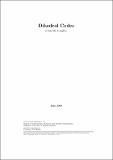| dc.description.abstract | In this thesis we give new constructions of a number of extremal type II codes. Algebraic proofs are provided that the constructions do in fact yield the codes. The codes are constructed using group rings of which the underlying groups are dihedral. Type II codes are not cyclic, but the constructions here are similar to the constructions of cyclic codes from polynomials. The first code we construct—the extended binary Golay code—is discussed in chapter 2. It is constructed from a zero divisor in the group ring of the finite field with two elements and the dihedral group with twenty-four elements. We create a generator matrix of the code that is in standard form and is a reverse circulant generator matrix. The generator matrix generates the code as quasi cyclic of index two. Algebraic proofs are given of the code’s minimum distance, self-duality and doubly evenness. A list of twenty-three other zero divisors that we have found to generate the code is given. Trivial changes adapt the aforementioned algebraic proofs to any of these zero divisors. We also prove that the twenty-four zero divisors are the only ones of their form that will generate the code. In chapter 3 we construct the (48, 24, 12) extremal type II code as a dihedral code. The new construction is similar to that of the extended Golay code. Again, proofs of the self-duality and doubly evenness are given. An algebraic proof of the minimum distance is achieved through the use of two different group ring matrices. A number of different codes are constructed in chapter 4, building on the constructions in previous chapters. Towards the end of the chapter we list some zero divisors that generate type II codes of lengths seventy-two and ninety-six. According to investigations by computer, these codes have minimum distances of twelve and sixteen respectively. No type II codes of each of these lengths are known that have greater respective minimum distances. Some techniques are detailed that vastly reduce the calculations involved in their analysis. The constructions of the (72, 36, 12) and (96, 48, 16) codes are facilitated at the start of chapter 4 by the construction of extremal type II codes of all lengths a multiple of eight up to length forty. Type II codes only exist at lengths that are multiples of eight. Overall we have shown that extremal type II codes can be constructed in dihedral group rings at every length a multiple of eight up to and including length forty-eight, and at some lengths beyond forty-eight. We also successfully investigate the possibility to construct some type I codes in the same way. | en_IE |


